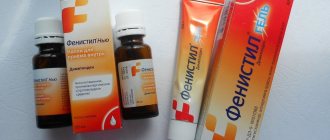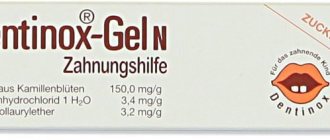Prepidil intracervical gel 0.5 mg syringe 3g complete with sterile catheter
Registration Certificate Holder
PFIZER MFG. BELGIUM (Belgium)
Dosage form
Medicine - Prepidil® (Prepidil®)
Description
Intracervical gel
translucent, viscous.
1 syringe (3 g)
dinoprostone 500 mcg
Excipients
: colloidal anhydrous silicon dioxide, triacetylglycerol (triacetylglycerol).
3 g - disposable polyethylene syringes (1) complete with catheter - contour plastic cell packaging (1) - cardboard packs.
Indications
- stimulation of cervical ripening in the presence of medical indications for induction of labor.
Contraindications for use
Conditions in which prolonged uterine contractions are contraindicated:
- multiple pregnancy;
- History of 6 or more full-term pregnancies;
- if the fetal head has not been inserted;
- caesarean section or major surgical interventions on the uterus (in history);
- difficult and/or traumatic birth (history);
- previous fetal distress;
- discrepancy between the sizes of the pelvis and the fetal head;
- fetal heart rhythm disturbances;
- obstetric situation in which surgical intervention is preferable;
- bloody discharge from the genital tract of unknown origin during pregnancy;
- infections of the lower genital tract;
- abnormal fetal presentation.
Hypersensitivity to the components of the drug.
Carefully _
The drug should be used for cardiovascular diseases, arterial hypertension, impaired liver and/or kidney function, bronchial asthma, glaucoma or ophthalmic hypertension, and for ruptured membranes.
pharmachologic effect
Labor stimulant. Dinoprostone (prostaglandin E2) is one of the representatives of unsaturated fatty acids synthesized under physiological conditions. The specific mechanism of action for intracervical use is not fully understood. It is believed that dinoprostone increases blood supply to the cervix, accelerating its maturation (softening, smoothing and opening), which corresponds to changes characteristic of normal labor, leading to a decrease in cervical resistance, a simultaneous increase in the contractile activity of the myometrium and delivery.
Dinoprostone can also have a stimulating effect on the smooth muscles of the human gastrointestinal tract, which can sometimes cause nausea and/or vomiting when the drug is prescribed for cervical ripening.
In high doses, dinoprostone can cause a decrease in blood pressure (possibly due to an effect on the smooth muscle of blood vessels), as well as an increase in body temperature; however, these effects are not observed when dinoprostone is used at doses recommended for cervical ripening.
Drug interactions
Dinoprostone enhances the effect of oxytocin on the uterus, so using the drug simultaneously with other drugs that stimulate labor is not recommended. Oxytocin can be used only 6 hours after administration of dinoprostone.
Dosage regimen
Initial dose:
the entire contents of the syringe (500 mcg of dinoprostone in 3 g of gel) are injected into the cervical canal just below the level of the internal os using the included catheter. After administration of the drug, the patient should lie on her back for 10-15 minutes to minimize leakage of the gel.
If the response to the initial dose of the drug is not achieved, the drug is re-administered. Recommended repeat dose
- 500 mcg, and the interval from the previous administration is at least 6 hours. The need for additional administration is determined based on the clinical situation. The maximum recommended cumulative dose over 24 hours is 1.5 mg.
Syringe assembly instructions
Remove the sterile syringe and catheter from the package.
1. Remove the protective cap from the tip of the syringe.
2. Insert the cap into the syringe to use it as a plunger.
3. Place the catheter tightly onto the tip of the syringe (until it clicks) and inject the contents of the syringe into the patient.
Overdose
Symptoms:
uterine hypertonicity, increased and frequent uterine contractions, fetal distress. The appearance of overdose symptoms indicates increased individual sensitivity to the drug, since a true overdose is unlikely due to the fact that the syringe with the drug contains a single dose.
Treatment:
symptomatic. The drug is removed from the vagina by placing the patient in a reclining position on her side. If simple drug withdrawal is not enough to stop uterine hyperstimulation and/or fetal distress, beta-agonists are administered intravenously. The use of oxygen is indicated. If ineffective, rapid delivery is required.
Side effect
From the mother's side:
tetanic contractions of the uterus (increased frequency, tone of the uterus or duration of contractions), uterine rupture, nausea, vomiting, diarrhea, increased body temperature, back pain, a feeling of warmth in the vagina, hypersensitivity reactions.
From the fetus:
fetal distress syndrome/changes in fetal heart rate, stillbirth, decrease in the assessment of the newborn's condition on the Apgar scale below 7 points (noted only when using dinoprostone in oral and injectable forms).
Post-marketing observations
From the blood coagulation system:
increased risk (less than 1 case per 1000 births) of postpartum disseminated intravascular coagulation in patients after labor stimulated by the use of dinoprostone or oxytocin.
special instructions
The drug is intended for use in a hospital setting only.
Before prescribing the drug, it is necessary to assess the correspondence between the sizes of the fetal head and the woman’s pelvis.
When using the drug, care should be taken to prevent the introduction of the gel above the level of the internal os into the extra-amniotic space (hyperstimulation of the uterus is possible).
While using the drug, you should monitor the process of ripening and dilatation of the cervix, and continuously monitor the contractile activity of the uterus and the condition of the fetus. If there is a history of hypertensive or tetanic uterine contractions, it is necessary to monitor the contractile activity of the uterus and the condition of the fetus throughout the entire period of induced labor. If uterine hypertonicity develops or uterine contractions become stronger and more frequent, as well as if the fetal heart rate changes, it is necessary to take measures aimed at ensuring the safety of the fetus and mother. You should be aware of the possibility of uterine rupture.
Women over 35 years of age with complications arising during pregnancy, as well as those with a gestational age of more than 40 weeks, have an increased risk of postpartum disseminated intravascular coagulation, so dinoprostone should be used with caution in such patients. It is necessary to determine as early as possible immediately after birth whether the patient is at risk of developing fibrinolysis.
Storage conditions
The drug should be stored out of the reach of children, in the refrigerator at a temperature of 2° to 8°C.
Best before date
Shelf life: 2 years.
Use during pregnancy and breastfeeding
Restrictions during pregnancy - With caution. Restrictions when breastfeeding - Contraindicated.
Any dose of the drug that causes a prolonged increase in uterine tone poses a certain risk to the embryo or fetus.
In experimental studies
In animals, prostaglandin E2 causes an increase in skeletal abnormalities in rats and rabbits, and embryotoxicity of dinoprostone in rats and rabbits has also been revealed.
Prostaglandins are excreted in breast milk in very small quantities, regardless of the period of delivery.
Terms of sale
The drug is available with a prescription.
Contacts for inquiries
PFIZER (USA)
Representative office in Russia Pfizer LLC 123112 Moscow, Presnenskaya embankment, 10 Business (Block C) Tel. Fax
PREPIDIL (gel)
was not found, but in any case I am grateful to the doctors for the fact that I still managed to experience the happiness and joy of motherhood twice.
I spent my first pregnancy, with a really good outcome, in a hospital, strict bed rest, constant monitoring and, of course, many medications as pregnancy-preserving therapy. Of course, this played a role, I think only in a positive context, the pregnancy was carried to term, up to forty weeks, but labor was in no hurry to begin, but even this was not so important for me, the most important fact for me was that my child is alive and well. I was given a week for everything to start on its own, and a week to finally take a break from such familiar, but still “hospital walls.” At forty-one weeks and three days, I was already expected to be hospitalized, after an examination the verdict was made that the cervix was absolutely not ready, but the size of the fetus and a narrow pelvis, this combination already raises concerns, so measures must be taken as soon as possible. Of course, the decision on the need for stimulation is made only by the doctor, together with the consultation. You should not take any extreme measures on your own, for example: walking up stairs, lifting heavy objects and taking medications without the prescription of specialists; the consequences can be sad, both for the child and directly for you, placental abruption, bleeding and of course the beginning of the labor process, but without an important criterion, there will be contractions, but due to the fact that everything will not happen when it is needed, the cervix simply will not have time to open in a timely manner, the result will be a caesarean section. Initially, a specialist (in the maternity hospital) will warn you that the remedy may be either ineffective, or will have absolutely no effect, or will finally have a positive effect on labor. If there is no result, literally at all, another method of stimulation will be undertaken, the benefit of which is more than sufficient in modern times. There is no need for any special preparation, there is simply no need for it, the main thing is to try to relax as much as possible, during the insertion process there are some unpleasant sensations, but you definitely can’t call them painful, and after that you need to lie down for at least a quarter of an hour, during the process the gel partially flows out , but at the same time it partially remains inside and has a significant effect on the opening of the cervix (at least this was the case for me!), thanks to biologically active substances - prostaglandins, which actually smooth and open the cervix.
You shouldn’t expect an immediate and immediate result, but you also need to remember that no one has had the chance to stay pregnant forever. After the introduction of the gel, delivery occurred within four hours, a very short period considering the fact that I was a first-time mother and finally I became a mother, the most long-awaited happiness that cannot be conveyed or expressed in words. I understand that much better in this option is a natural process that begins on its own, but sometimes you don’t have to choose. The cost of the drug cannot be called affordable (especially considering the fact that you will have to use it only once) and it is currently seven hundred and seven rubles. As far as I know, girls and women now buy this drug on their own, for their own money, with a prescription from a specialist When I gave birth, the drug was administered completely free of charge. Of course, I don’t know why such changes occurred, but when it comes to your health and the health of your child, you don’t feel sorry for any money. Not recommending a truly effective remedy for stimulating labor, without side effects, is simply stupid, so I definitely recommend it, but only under the supervision of specialists.



